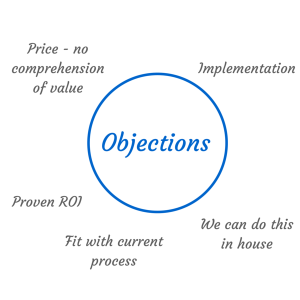When I first started creating content for sales teams, I would follow a similar process to my own marketing efforts. Educate and deliver specific types of value depending on what stage of the sales cycle website visitors and leads were at.
Turns out I was doing it all wrong. This isn’t how salespeople use content to educate their opportunities.
Creating content for sales enablement is a very different game to how we create it for marketing. You’re creating it to help your sales team close more deals. You need to forget about top and bottom-of-funnel here. The sales process isn’t that straightforward.
Follow these steps and you’ll become the hero among your sales department.
Step 1: Understand your sales teams’ challenges.
Salespeople are at the front line of your audience. They’re talking to buyers every single day and understand your clients and their challenges very well.
Therefore, the first step to sales enablement content is to gather insight. Start by digging deep into as many objections as possible. Find the most common and then dig deeper to see what the hurdles of getting over them are.
Set aside some time to do this. Gathering everyone into a workshop environment can help get people in the right mindset to do this.
When eliciting and taking note of this insight, apply them to categories. We find the best way to do this is in the form of mindmaps:
 Finally, be sure to share what you’ve got lined up in your editorial calendar. Sales can come up with great ideas on how to use, improve and optimise content for their own purposes. Keep them in the loop.
Finally, be sure to share what you’ve got lined up in your editorial calendar. Sales can come up with great ideas on how to use, improve and optimise content for their own purposes. Keep them in the loop.
Step 2: Customise the content experience
High performing salespeople never stick to a set script, and the same is true for the content you create for them. Every piece of content they use should help guide prospects towards taking the next step.
The hurdles to these next steps are the objections and challenges you’re helping your salespeople to overcome. Because of this, no one experience will ever be the same. You need to customise the experience to each prospect.
Sure, you can optimise your CRM to keep track of who has received what, but this presents a challenge on the prospects’ side. B2B marketing usually involves more than one decision maker, which makes sharing the content for your point of content a messy task.
Instead, create an environment that contains specific content for certain segments. Content is all grouped together and can be share with one link. Go one step further and get engineering resources to create a system that allows you to build an environment for each prospect.
Whichever approach you go for, you need to make it easy for your sales teams to make it easy for their prospects.
Step 3: Enable your sales reps
Now you have an understanding of the overall objections and challenges your sales teams and prospects. Everything should be mapped out and content should be ready for your sales to use. Now it’s time to make it easy for them.
First things first – get your CRM in order. Optimise email templates to include links to whitepapers. You can integrate this into the overall messaging or include P.S. statements.
Secondly, create a content library to provide easy access to your content. HubSpot and KISSmetrics both do this very well you can use for inspiration – but be sure to use them on an internal basis only.
Conclusion
Providing your sales teams with content really helps them to speed things along. Certain challenges can quickly be overcome in a way that makes them look trusted and authoritative.
We’ve scratched the surface of the entire sales enablement process here, but it gives you a good starting point to work from.
The key here is to really, really listen. Elicit as much information as possible and go many layers deep. Not only will this benefit your sales teams, but may also give you insight to apply to your marketing efforts.
This article was syndicated from Business 2 Community: How to Build Content for Sales Enablement
More Sales & Marketing articles from Business 2 Community:




